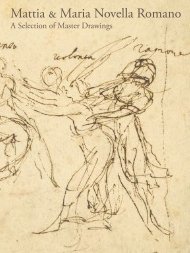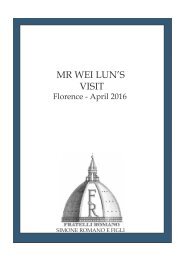A Selection of master drawings 2014
- No tags were found...
Create successful ePaper yourself
Turn your PDF publications into a flip-book with our unique Google optimized e-Paper software.
the fresco by Gabbiani, Aldo Bartarelli, Domenico Gabbiani, in “Rivista d’arte”, 1953, XXVII, pp. 107-130, in particular, pp. 119-120.<br />
4 Hugford wrote (1762, p.19): Il Cavalier Giulio Orlandini del Beccuto, Priore della Religione de’ Cavalieri di Santo Stefano, gode in un bel<br />
salotto un grande sfondo in forma pentagona del nostro Gabbiani, dove nel 1697 con un saporitissimo gusto vi rappresentò la Liberalità, che tien<br />
per mano la Virtù, e la solleva, in vista de’ Vizj confusi, e dell’Invidia, che si lacera il cuore, ed intanto Mercurio con Pallade, e le Grazie additano<br />
al nobil Genio d’un Giovane il bel consesso d’Apollo colle Muse, che stanno sul Parnaso, mentre Omero cantando, rapisce l’animo delle Ninfe<br />
de’ boschi, e de’ Pastori, che vedonsi attentissimi ad ascoltarlo, e vi si leggono spartiti in cinque cartelle i seguenti motti. Dalla parte di Pallade:<br />
MERCURIUS, PALLAS, PHOEBUS: PROCUL ESTE PROFANI, INFUNDUNT MENTI SEMINA DIA SACRAE…<br />
5 70 pitture e sculture del ‘600 e ‘700 fiorentino, exh. cat., curated by Mina Gregori, Florence, 1965, p. 30.<br />
6 Bartarelli 1952, p. 119.<br />
7 On the <strong>drawings</strong> by Gabbiani in the Gabburri Collection see Novella Barbolani Di Montauto, Nicholas Turner, Dalla collezione Gabburri<br />
agli Uffizi: i disegni di Anton Domenico Gabbiani, in “Paragone”, 75-76, 2007, pp. 27-92. In particular the drawing is described as: “N.o 947,<br />
Figura panneggiata veduta in rene, con elmo in testa a lapis nero, lumeggiata sopra carta turchiniccia. Per alto soldi 13 5/6, largo 8 2/3”.<br />
Literature:<br />
F.S. Baldinucci, Vite di artisti dei secoli XVII-XVIII (1725-30 circa), ed. by A. Matteoli, Rome, 1975; I.E. Hugford, Vita di Anton Domenico<br />
Gabbiani pittor fiorentino, Florence, 1762; A. Bartarelli, Domenico Gabbiani, in “Rivista d’arte”, 27, 1951 (1952), pp. 107-128; 70 pitture<br />
e sculture del ‘600 e ‘700 fiorentino, exh. cat. by M. Gregori, Florence, 1965; L. Ginori Lisci, I palazzi di Firenze, Florence, 1972; M.<br />
Chiarini, Anton Domenico Gabbiani e i Medici, in Kunst des Barock in der Toskana, München, 1976, pp. 333-343; M. Chiarini, Postilla al<br />
Gabbiani, in “Mitteilungen des Kunsthistorisches Institutes in Florenz”, XXI, 1977, pp. 329-334; Il Gran Principe Ferdinando de’ Medici e<br />
Anton Domenico Gabbiani: mecenatismo e committenza artistica ad un pittore fiorentino della fine del Seicento, exh. cat. by R. Spinelli, Prato, 2003;<br />
N. Barbolani Di Montauto, N. Turner, Dalla collezione Gabburri agli Uffizi: i disegni di Anton Domenico Gabbiani, in “Paragone”, 75-76,<br />
2007, pp. 27-92; Il Gran Principe Ferdinando de’ Medici (1663 - 1713); collezionista e mecenate, exh. cat. by R. Spinelli, Florence, 2013.<br />
9. François Lemoyne<br />
1 Ovid (Metamorfosi, libro XI, capo 135); Apollodoro (Biblioteca, libro II, capo 5). Ovid, Apollodoro and a few other sources narrate that<br />
Hesione, daughter <strong>of</strong> King Laomedon <strong>of</strong> Troy, was sacrificed by her father to a sea monster to allay the anger <strong>of</strong> Phoebus Apollo and<br />
Poseidon. Disguised as humans, they built the walls <strong>of</strong> the city for him but Laomedon refused them the reward he had promised, and<br />
expelled them from his dominions. Hercules, having fought the Amazons and finding himself near Troy accepted the challenge to kill the<br />
monster knowing that Laomedon was <strong>of</strong>fering, as a reward, the two horses that Zeus had gifted to him. Not only was he successdul in<br />
killing the monster but he also freed Hesione. The King once again showed his treachery and kept the horses.<br />
2 “Le rayon rose”, as it is defined by Paul Mantz, was not invented by French but by Italian painters as it was already employed by Luca Giordano<br />
and Sebastiano Ricci. Mantz further points out that François Lemoyne anticipated François Boucher in the use <strong>of</strong> this tonality which had so<br />
much success that “le rose deviendra la couleur du temps”, see Paul Mantz, François Boucher, Lemoine, Natoire, Paris, 1880, pp. 20-21.<br />
3 William Algernon Churchill, Watermarks in paper in Holland, England, France, etc., in the XVII and XVIII centuries and their interconnection,<br />
Amsterdam, 1990, p. CCCIV, n. 409.<br />
4 The painting, signed and dated “1729”, is part <strong>of</strong> the collections <strong>of</strong> the Musée des Beaux Arts de Nancy (inv. 925) and is stored since 1998<br />
at the Musée Rodin in Paris which occupies the hôtel Peyrenc de Moras, see Jean-Luc Bordeaux, François Le Moyne and his generation,<br />
Neuilly-sur-Seine, 1985, p. 117, P 85, fig. 83.<br />
5 On the works by François Lemoyne executed for the hôtel Peyrenc de Moras, see Jean-Luc Bordeaux, François Lemoyne et la décoration de<br />
l’hôtel Peyrenc de Moras, in “Gazette des Beaux-Arts”, 1971, 113, pp. 65-76.<br />
6 The sheet has in fact been irregularly cut down to the right edge.<br />
7 See the wonderful portrait-like heads <strong>of</strong> the figures. Dézallier d’Argenville noted that in the frescoes in the Hercules Salon at Versailles:<br />
“…all the heads have been executed with a certain degree <strong>of</strong> individuality and are very pleasant …”, see Dézallier d’Argenville, Abregé,<br />
1745-1762, vol. IV, p. 423.<br />
8 Paris, Louvre, Cabinet des Dessins, Inv. 30517, black and white chalk on blue paper. see Bordeaux 1985, p. 165, D 120, fig. 247.<br />
9 Paris, Louvre, Cabinet des Dessins, Inv. 30552, black and white chalk on cream paper. See Bordeaux 1985, p. 143, D 9, fig. 135. See also<br />
a similar study, Idem, p. 143, D 9, fig. 136 (Adrien Collection).<br />
Paris, Louvre, Cabinet des Dessins, Inv. 31410, black, red and white chalk on cream paper. See Idem, p. 160, D 93, fig. 221.<br />
London, British Museum, Inv. 1850-3-9-1, pastel over red, black and white chalk on blue paper. See Idem, p. 171, D 147, fig. 274.<br />
Charles Blanc, Histoire des Peintres de toutes les écoles. École Française, Paris, 1862, p. 11.<br />
Charles Blanc 1862, p. 8: “…On pensa donc naturellement à lui, quand il fut question de peindre le grand salon qui est à l’entrée des<br />
appartements de Versailles, et le roi, enchanté d’une esquisse très-finie que Lemoyne lui avait présentée, le chargea de tout le travail…”<br />
Literature:<br />
A.J. Dézallier D’Argenville, Abrégé de la vie des plus fameux peintres, Paris, 1745-1762, 4 vol.; C. Blanc, Histoire des Peintres de toutes les écoles,<br />
Paris, 1862, 11 vol.; P. Mantz, François Boucher, Lemoine, Natoire, Paris, 1880; Le cabinet d’un grand amateur. P.J. Mariette, exh. cat. by M.<br />
Sérullaz, Paris, 1967; J.-L. Bordeaux, François Lemoyne et la décoration de l’hôtel Peyrenc de Moras, in “Gazette des Beaux-Arts”, 1971, 113, pp.<br />
65-76; The age <strong>of</strong> Louis XV: French painting 1710-1774, exh. cat. By P. Rosenberg, Toledo (Ohio), 1975; J.-L. Bordeaux, François Le Moyne and<br />
his generation, Neuilly-sur-Seine 1985; Dessins français du XVIIIe siècle de Watteau à Lemoyne, exh. cat. by R. Bacou, Paris, 1987; M.R. Michel, Le<br />
dessin français au XVIIIe siècle, Paris, 1987; W.A. Churchill, Watermarks in paper in Holland, England, France, etc., in the XVII and XVIII centuries<br />
and their interconnection, Amsterdam, 1990; La collection de dessins d’Antoine-Joseph Dezallier, exh. cat. by J. Labbé, Paris, 1996; F. Marandet,<br />
Louis Galloche et François Lemoyne: caractères distinctifs et oeuvres inédites, in «La revue des musées de France», LVII, 2007, pp. 29-36.<br />
10<br />
11<br />
12<br />
13<br />
10. Ubaldo Gandolfi<br />
1 See D. Biagi Maino. U. Gandolfi, Torino, 1990, pp. 27-28, 247-248, no.4.<br />
2 Milan, Gabinetto di Disegni e Stampe, Inv. No. 389/II.





